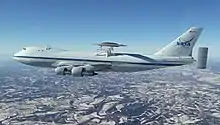Boeing Phantom Ray
The Boeing Phantom Ray is an American demonstration stealth unmanned combat air vehicle (UCAV) developed by Boeing using company funds. The autonomous Phantom Ray is a flying wing around the size of a conventional fighter jet, and first flew in April 2011. It will conduct a program of test flights involving surveillance, ground attack and autonomous aerial refueling missions.[2][3] The developers say it can carry 4,500 pounds (2,040 kg) of payload.[4]
| Phantom Ray | |
|---|---|
 | |
| The Phantom Ray during its unveiling in St. Louis, Missouri, in May 2010. | |
| Role | Unmanned Combat Air Vehicle |
| Manufacturer | Boeing Integrated Defense Systems |
| First flight | April 27, 2011[1] |
| Status | Under development |
| Number built | 1 |
| Developed from | Boeing X-45C |
Design and development

The Phantom Ray project, called "Project Reblue" internally at Boeing, was first conceived in mid-2007, and started in earnest in June 2008. The project was secret within the company, except for a small number of executives and engineers, until May 2009.[5]
Developed by the Boeing Phantom Works, the Phantom Ray is based on the X-45C prototype aircraft,[6] which Boeing originally developed for the Defense Advanced Research Projects Agency (DARPA), the US Air Force, and the US Navy Joint Unmanned Combat Air Systems (J-UCAS) program in 2002. The Phantom Ray was not aimed at any particular military program or competition,[7] although Boeing considered using the design as an entry for the Navy's Unmanned Carrier-Launched Surveillance and Strike (UCLASS) program.[8]
The Phantom Ray was unveiled on May 10, 2010, in St. Louis, Missouri.[3][9] In November 2010, low-speed taxi tests were carried out in St. Louis.[10][11] The demonstrator aircraft is to perform ten test flights over six months, supporting missions such as intelligence, surveillance and reconnaissance; suppression of enemy air defenses; seek-and-destroy;[12] electronic attack; hunter/killer; and autonomous aerial refueling.[2] Boeing anticipates that the Phantom Ray will be the first of a series of new prototype aircraft.[3]
The Phantom Ray was scheduled to make its maiden flight in December 2010 from NASA's Dryden Flight Research Center,[3][10] but this was later rescheduled, and the aircraft first flew on April 27, 2011, from Edwards AFB,[13][14][15] having been carried there by the Boeing 747 Shuttle Carrier Aircraft.[13][15][16][17] The Phantom Ray flew to 7,500 feet and reached a speed of 178 knots,[18] flying for a total of 17 minutes.[19][20]
Specifications
Values for the X-45 are marked with an asterisk (*).
Data from Debut,[3] Boeing backgrounder,[21] Boeing X-45 page[22]
General characteristics
- Crew: None (UCAV)
- Length: 36 ft (11 m)
- Wingspan: 50 ft (15 m)
- Max takeoff weight: 36,500 lb (16,556 kg)
- Powerplant: 1 × General Electric F404-GE-102D
Performance
- Cruise speed: 614 mph (988 km/h, 534 kn) mach 0.93
- Range: 1,500 mi (2,400 km, 1,300 nmi) *
- Service ceiling: 40,000 ft (12,000 m) *
See also
Aircraft of comparable role, configuration, and era
- BAE Taranis
- Dassault nEUROn
- DRDO AURA
- EADS Barracuda
- Northrop Grumman X-47B
- Mikoyan Skat
- Sukhoi Okhotnik
Related lists
References
- "Pictures: Phantom Ray first flight raises funding hopes". Flight Global. May 4, 2011. Retrieved February 5, 2013.
- "Boeing to Develop, Fly 'Phantom Ray' Technology Demonstrator" Archived March 10, 2010, at the Wayback Machine. Boeing. May 8, 2009. Retrieved February 6, 2013.
- Jackson, Randy. "Phantom Ray makes its debut in St. Louis" Archived May 14, 2010, at the Wayback Machine. Boeing. May 10, 2010. Retrieved June 17, 2013.
- http://www.foxnews.com/tech/2010/05/11/boeing-unveils-phantom-ray-drone/
- Butler, Amy. "Boeing Unveils ‘Phantom Ray’ Combat UAS Demonstrator". Aviation Week, May 11, 2009. Retrieved February 6, 2013.
- "Boeing's Phantom Ray – the 'Phoenix' of UCAVs". Aviation Week. Retrieved February 6, 2013.
- "Breaking: Boeing resurrects X-45C as 'Phantom Ray' testbed". Flight Global, May 8, 2009. Retrieved February 6, 2013.
- "US Navy delays UCLASS RFP". Flight Global, December 11, 2012. Retrieved February 6, 2013.
- Page, Lewis (May 11, 2010). "'Phantom Ray' robot stealth jet rolls out". The Register. Retrieved May 12, 2010.
- Doyle, Andrew (August 25, 2012). "AUVSI: Boeing makes progress with unmanned programmes". Flight Global. Retrieved February 6, 2013.
- "Boeing Phantom Ray Completes Low-speed Taxi Tests". Boeing, November 22, 2010. Retrieved February 6, 2013.
- http://www.popsci.com/science/article/2010-12/phantom-ray-drone-makes-its-first-flight-piggyback-ride-shuttle-carrier-747
- Trimble, Stephen. "Phantom Ray first flight raises funding hopes". Flight International. May 4, 2011. Retrieved February 6, 2013.
- "Video: Phantom Ray Drone Makes Maiden Solo Flight". Popular Science. May 4, 2011. Retrieved February 6, 2013.
- "Boeing Phantom Ray Takes a Ride on NASA's Shuttle Carrier Aircraft". Boeing. December 13, 2010. Retrieved February 6, 2013.
- LaBelle, Kurt. "Phantom Ray Takes A Piggy Back Ride On 747" Archived December 17, 2010, at the Wayback Machine. KTVI via fox2now.com, December 13, 2010. Retrieved February 6, 2013.
- https://gizmodo.com/5798126/boeing-phantom-ray-the-future-of-unmanned-terror-in-the-sky
- http://boeing.mediaroom.com/2011-05-03-Boeing-Phantom-Ray-Completes-1st-Flight
- https://www.engadget.com/2011/05/03/boeings-phantom-ray-soars-like-a-terrifying-unmanned-eagle/
- http://www.foxnews.com/tech/2011/05/05/boeings-gen-drone-phantom-ray-takes-maiden-flight.html
- Phantom Ray Backgrounder (PDF) Archived March 6, 2010, at the Wayback Machine. Boeing. February 2010. Retrieved June 17, 2013.
- X-45 Joint Unmanned Combat Air System Archived March 23, 2008, at the Wayback Machine. Boeing. Retrieved June 17, 2013.